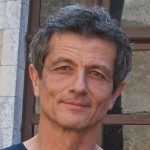Link to Pubmed [PMID] – 2088498
New Biol. 1990 Dec;2(12):1063-70
In eukaryotes, activation of transcription by RNA polymerase II results characteristically from the synergistic effects of several cis-acting DNA motifs. These motifs, which are arranged in distinct sets that are often dispersed over large distances around the site of transcription initiation, bind specific transcription factors (TFs). The diversity of the combinations of motifs involved in the transcription of various genes, and the experimental testing of further, artificial combinations, has led to the conclusion that virtually any two functional motifs, whether identical or distinct, can work synergistically in a suitable cellular context. It has been proposed that this puzzling functional promiscuity might result from the potential of several TFs to bind simultaneously, and therefore cooperatively, to the same protein target, presumably some component of the preinitiation complex. Here I review the emergence of this notion and explore some of its implications. It appears sufficient by itself to account for most traits of synergism found experimentally, notably the widespread but poorly understood observation that synergism among sets of DNA motifs (for instance enhancer and upstream promoter regions) can occur over much larger distances than among individual motifs within a given set.
